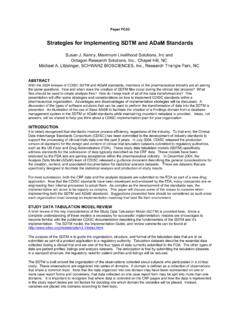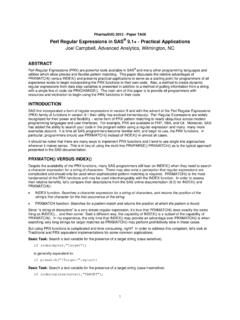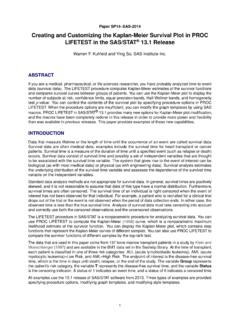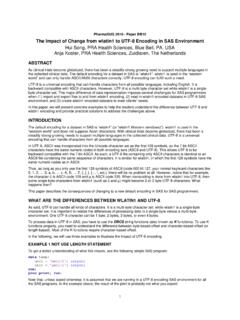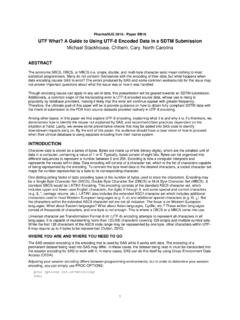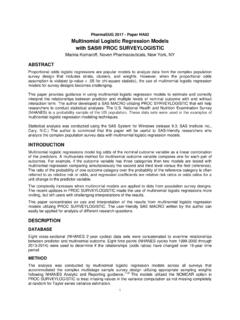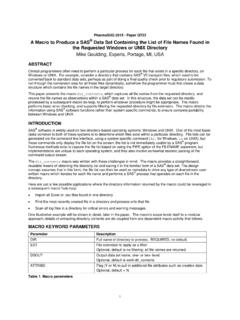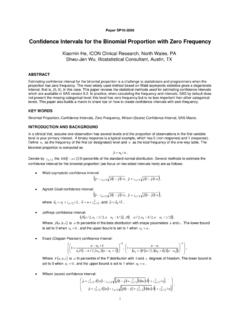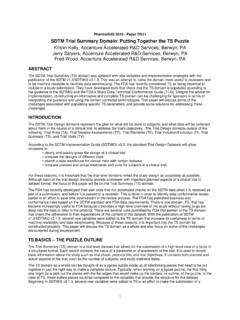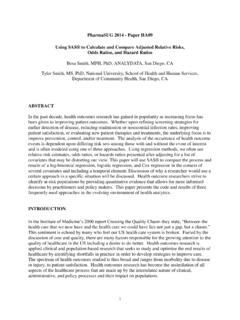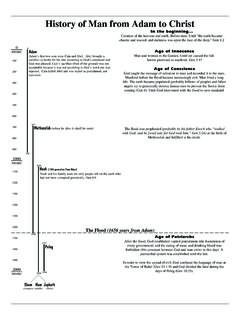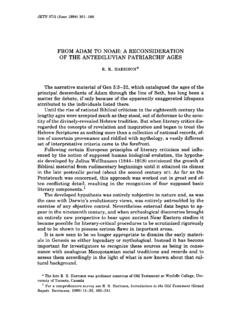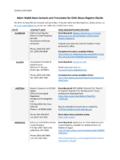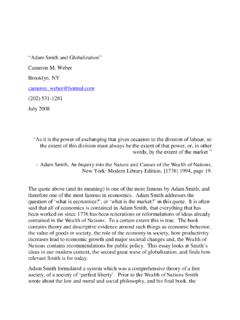Transcription of Raw ADaM TLFs - Pharmasug
1 1 PharmaSUG2011 Paper CD22 Truncation, Variable Association, Controlled Terminology, and Some Other Pitfalls in the SDTM Mapping Process Na Li, XenoPort, Inc., Santa Clara, CA Gary de Jesus, Infovision, Inc., Richardson, TX Daniel Bonzo, XenoPort, Inc., Santa Clara, CA ABSTRACT This paper discusses a class of likely pitfalls during the SDTM mapping process. Problems in truncation, variable association, controlled terminology, and mapping SUPPQUAL usually occur when SDTM mapping proceeds from raw to SDTM and then using SDTM to generate ADaM. In this pathway, understanding data standards and data capture and reporting instruments from CRF to TLFs (Tables, Listings and Figures) is critical to mitigating potential errors that are embedded in the mapping process. Some collective experience in identifying and preventing these pitfalls will be shared.
2 INTRODUCTION Since acceptability of using Study Data Tabulation Model (SDTM) format has been established for electronic submissions, pharmaceutical companies are moving forward with the implementation of SDTM and Analysis Data Model (ADaM). There are several pathways to implement the mapping process from raw clinical data to generating TLFs (Tables, Listings, and Figures). One particular pathway is to use the mapping Raw Data SDTM ADaM TLFs (as shown below). In this approach, the raw data (SAS datasets) come from Oracle Clinical (OC) extract using in-house database standards which are SDTM-like. The data are mapped from OC to SDTM using CDISC-SDTM IG (implementation guide). ADaM data sets are then generated using CDISC-ADaM IG. Note that both SDTM and ADaM data are required to have a vertical structure, while raw data normally come in horizontal structure.
3 The preservation of data integrity from the horizontal structure into the vertical structure can be problematic at times. Furthermore, the creation of ADaM data sets using SDTM data sets as source can also be problematic not to mention the generation of the resulting TLFs. This paper will focus on mapping process and will not attempt to cover resulting problems in the creation of TRUNCATION OF LONG TEXT FIELDS The SDTM IG instruction for long text field with more than 200 characters is detailed in SDTM section The instruction states to keep the first of the 200 characters in the standard domain and keep the rest 200 characters of text in Supplemental Qualifiers (SUPP--) domain. Long text fields should be given special attention during the mapping process. If segmentation is not done correctly the information from the original data can be lost.
4 Furthermore, in order to generate TLFs using such information, the standard SDTM domain needs to be merged with SUPP-- domains. Correctly merging all of the segments together is essential in maintaining the data integrity of the TLFs. The potential long text information may also be mapped in the following manner: CO for comment related fields; TI for trial inclusion/exclusion criteria; DV for protocol deviation detail; and LB/EG for abnormality interpretation. Raw Data SDTM ADaM TLFs 2 Long text fields in CO and TS (Trial Summary) are allowed in its standard domain. The first 200 characters of text can be put under --VAL and the remaining text can be put into --VAL1 to --VALn for each 200 character segments for the rest of the text. Long texts in TI can be handled in the metadata.
5 If the length of the text criterion is <= 200 characters, putting it in IETEST should be sufficient. If the length of the text is >200 characters, a meaningful text should be put in IETEST and the full text can be put in the metadata. In other domains, the first 200 characters can be mapped into the standard domain variable and data set and the remaining text can be mapped into the SUPP-- domains. Consider the Excel file below as a source data shown below. It contains information on protocol deviations. In this case, the information can be mapped into the DV domain. Note that the Deviation Description column s contents are more than 200 characters long. Deviation Deviation Unique Subject SOURCE LEVEL Table number item number Identifier SCOPE Deviation Description CRA MINOR 10 2 XXX DATA According to the protocol, PK samples must be stored at -70 C 10 C until shipment.
6 All whole blood and plasma PK samples for the Period 4 time points, Hour through Hour were out of range on 25-September-2009, reaching a high of -58 C for approximately hours. CRA MINOR 10 2 XXX DATA According to the protocol, whole blood and plasma PK samples must be stored at -70 10 C within 30 minutes of quenching/collection, respectively. The samples listed below were late to freezer in error: Period 1, Hour , Whole blood 6 min late; Period 3, Hour , Plasma 2 min late. Following the suggested mapping process, the information in DV domain should look like the table below. DOMAIN USUBJID DVSEQ DVSPID DVTERM DVCAT DV XXX 3 According to the protocol, PK samples must be stored at -70 C 10 C until shipment.
7 All whole blood and plasma PK samples for the Period 4 time points, Hour through Hour were out of range MINOR DV XXX 4 According to the protocol, whole blood and plasma PK samples must be stored at -70 10 C within 30 minutes of quenching/collection, respectively. The samples listed below were late to freezer in MINOR 3 As shown above, only the first segment with about 200 characters of text was kept in DVTERM field in DV. The remaining text information was put under SUPPDV and should look like the table below. RDOMAIN USUBJID IDVAR IDVARVAL QNAM QLABEL QVAL QORIG SUPPDV XXX DVSEQ 3 DVTERM1 Deviation Text on 25-September-2009, reaching a high of -58 C for approximately hours.
8 DERIVED SUPPDV XXX DVSEQ 4 DVTERM1 Deviation Text error: Period 1, Hour , Whole blood 6 min late; Period 3, Hour , Plasma 2 min late. DERIVED Now, in order to correctly report protocol deviations in the required TLFs, SUPPDV domain needs to be merged with the DV domain using the IDVARVAL and DVSEQ as the keys. This can be done using the SAS codes below: proc sort data= out=suppdv; by usubjid idvarval qnam; run; proc transpose data=suppdv out=tdv(drop=_name_ _label_); var qval; id qnam; idlabel qlabel; by usubjid idvarval; run; data tdv; length dvseq 8; set tdv; dvseq=input(idvarval, ); drop idvarval; run; data dv; merge tdv; by usubjid dvseq; length fulltext $ 2000; ** depends on the # of text string segments; fulltext=strip(dvterm)|| ||strip(dvterm1)|| ||strip(dvterm2); run; The resulting listing report should come out as follows: Subject No.
9 Type of Deviation Deviation Identifier Description of Deviation/Violation xxx MINOR According to the protocol, PK samples must be stored at -70 C 10 C until shipment. All whole blood and plasma PK samples for the Period 4 time points, Hour through Hour were out of range on 25-September-2009, reaching a high of -58 C for approximately hours. 4 Subject No. Type of Deviation Deviation Identifier Description of Deviation/Violation MINOR According to the protocol, whole blood and plasma PK samples must be stored at -70 10 C within 30 minutes of quenching/collection, respectively. The samples listed below were late to freezer in error: Period 1, Hour , Whole blood 6min late; Period 3, Hour , Plasma 2min late.
10 VARIABLE ASSOCIATION ERRORS IN A GROUP OF RELATED RECORDS SDTM IG section 8 focuses on representing relationships and data. Section describes the relationship among a group of records for a given subject within the same use of Group Identifier (--GPRID) to link related records for a subject is recommended. Also in IG section , the detailed instruction on Findings About Events or Interventions describes how to group the associated information in the FA domain. The variable FAOBJ is designated for such a purpose. This section shows an example of a pitfall in generating the FA domain. The same principles apply to other SDTM standard domains using --GRPID. In OC-based electronic data capture systems, eCRFs are designed such that a group of variables/questions are related to a specific record.
